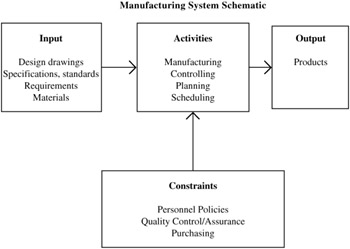THE MANUFACTURING PROCESS
Figure 5.6 shows a schematic of a manufacturing system. There are four categories of manufacturing processes. They are:
-
Fabrication process ” which can be further categorized as basic process, secondary process, or finishing process. Typical types are:
-
Single station
-
Continuous production flow
-
Pace production line
-
Manufacturing cell approach
-
-
Assembly process ” which can be further categorized as manual assembly, mechanical assembly, automatic assembly, or computer-aided assembly. Typical types are:
-
Continuous transfer
-
Intermittent transfer
-
Indexing mechanisms
-
Operator-paced free-transfer machine
-
-
Inspection or quality control process
-
Inspection check point(s)
-
-
Material handling process
-
Conveyors
-
Tractors
-
Fork lifts
-
Parts/component feeding system:
-
Vibratory bowl feeder
-
Reciprocating tube hopper feeder
-
Centerboard hopper feeder
-
Reciprocating fork hopper feeder
-
External gate hopper feeder
-
Rotary disk feeder
-
Centrifugal hopper feeder
-
Revolving hook hopper feeder
-
Stationary hook hopper feeder
-
Bladed wheel hopper feeder
-
Tumbling barrel hopper feeder
-
Rotary centerboard hopper feeder
-
Magnetic disk feeder
-
Elevating hopper feeder
-
Magnetic elevating hopper feeder
-
-

Figure 5.6: Manufacturing system schematic.
Approaches to manufacturing processes include the job shop approach, the assembly line approach, and the one in, one out approach. Details of these processes are as follows :
-
Singled station manufacturing process ” job shop approach
-
Definition: Single fixture with one or more operations performed
-
Advantages:
-
Capital investment ” low
-
Line balance ” not needed
-
Interference with other operations (downtime) ” minimum, if any
-
Flexibility ” easy to expand or rearrange
-
Employment fulfillment ” high
-
-
Disadvantages:
-
Multiple tooling/fixture investment ” high
-
Material handling ” high
-
Material flow ” easy to congest at in/out
-
Operation cycle time ” long
-
Operator skills ” moderate
-
-
-
Continuous production flow manufacturing process ” assembly line approach
-
Definition: Continuous, sequential motion assembly/manufacturing approach
-
Advantages:
-
Work-in-process ” low
-
Manufacturing/assembly cycle time ” low
-
Material handling ” very low, if not eliminated
-
Material flow ” good
-
Operator skill/training ” only in specialized areas
-
-
Disadvantages:
-
Capital investment ” high
-
Preventative maintenance and corrective maintenance ” absolute necessity (If one part breaks down, the entire line is down.)
-
Engineering, technician, and flow disciplines ” absolute necessity
-
Flexibility ” low
-
Production changeover ” complicated
-
-
-
Pace production line ” one in, one out
-
Definition: Same cycle time at all work stations , and likely all work pieces transfer at the same time
-
Advantages:
-
Work-in-process ” very low and can be calculated
-
Material handling ” automatic
-
Material flow ” good
-
Productivity ” best
-
-
Disadvantages:
-
Capital investment ” high
-
Preventative maintenance and corrective maintenance ” absolute necessity (If one part breaks down, the entire line is down.)
-
Engineering, technician, and flow disciplines ” absolute necessity
-
Flexibility ” very low
-
Production changeover ” difficult
-
-
EAN: 2147483647
Pages: 235